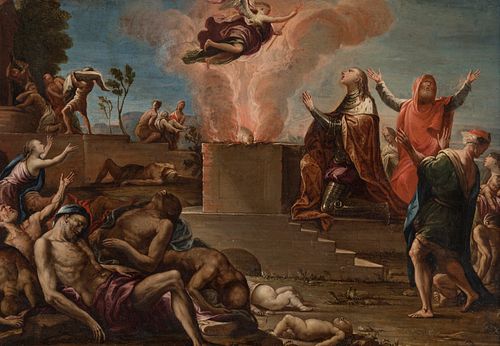Italian school; late sixteenth century-early seventeenth century. "King David before the altar". Oil on copper.
Lot 53
About Seller
Setdart Auction House
Carrer Aragó 346
Barcelona
Spain
Setdart Subastas was born in 2004 and is currently the first online art auction in Spain with solidity, prestige and reliability guaranteed by our more than 60,000 users. Setdart has a young, dynamic and enterprising team ready to successfully manage the purchase and sale of art works through custom...Read more
Estimate:
EUR€3,000 - EUR€4,000
$3,225.81 - $4,301.08
Absentee vs Live bid
Two ways to bid:
- Leave a max absentee bid and the platform will bid on your behalf up to your maximum bid during the live auction.
- Bid live during the auction and your bids will be submitted real-time to the auctioneer.
Bid Increments
| Price | Bid Increment |
|---|---|
| EUR€0 | EUR€10 |
| EUR€200 | EUR€25 |
| EUR€500 | EUR€50 |
| EUR€1,000 | EUR€100 |
| EUR€3,000 | EUR€200 |
| EUR€5,000 | EUR€500 |
| EUR€10,000 | EUR€1,000 |
| EUR€20,000 | EUR€2,000 |
| EUR€50,000 | EUR€5,000 |
About Auction
By Setdart Auction House
Oct 20, 2021
Set Reminder
2021-10-20 07:30:00
2021-10-20 07:30:00
America/New_York
Bidsquare
Bidsquare : OLD MASTERS
https://www.bidsquare.com/auctions/setdart-auction-house/old-masters-7700
Setdart Auction House sofia@setdart.com
Setdart Auction House sofia@setdart.com
- Lot Description
Italian school; late sixteenth century-early seventeenth century. "King David before the altar". Oil on copper. Presents repainting. Size: 32 x 47 cm; 51 x 64 cm (frame). This work of classical composition, marked by a certain symmetry and a harmonic game that balances the contrasts of the tonalities used, is inscribed in the aesthetic framework of the Italian school. The representation of the scene, which stands out for the profusion and dynamism of the figures, introduces the biblical theme narrated in Samuel 24. In this passage it is told how King David decides to create a census of the people of Israel, being incited by the devil, since with this act he contradicted the advice of the general Joab. After unleashing the wrath of God with his act, David is punished to three years of famine, three months of devastation by the sword of his enemies or three days of pestilence in the land. Finally, having to decide between these three premises, David decides for the last one, whose direct consequence is the death of seventy thousand people, provoked by the angel of death. In this situation David turns to God, "Am I not the one who commanded to number the people? Surely I am the one who has sinned and acted very wickedly, but these sheep, what have they done? O Lord my God, I beseech You, let Your hand be against me and against my father's house, but not against Your people, that there be no plague among them. Finally, David built an altar where he made sacrifices as an offering to God, who finally removed the plague. Formally, this work is dominated by the influence of the Roman-Bolognese classicism of the Carracci and their followers, one of the two great currents of the Italian Baroque, together with Caravaggio's naturalism. Thus, the figures are monumental, with idealized faces and serene and balanced gestures, in an idealized representation based on classical canons. Also the rhetoric of the gestures, theatrical and eloquent, clearly baroque, is typical of the Italian classicism of the XVII century. It is also worth mentioning the importance of the chromatic aspect, very thoughtful, intoned and balanced, centered on basic ranges around red, ochre and blue. Also the way of composing the scene, with a circular rhythm, typical of this school of baroque classicism.
- Shipping Info
-
In-house shipping available. Please inquire at admin@setdart.com.
-
- Buyer's Premium



 EUR
EUR CAD
CAD AUD
AUD GBP
GBP MXN
MXN HKD
HKD CNY
CNY MYR
MYR SEK
SEK SGD
SGD CHF
CHF THB
THB









